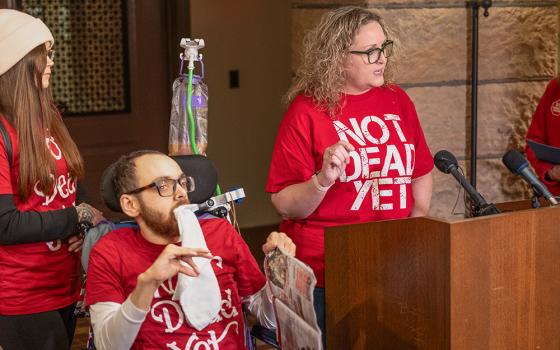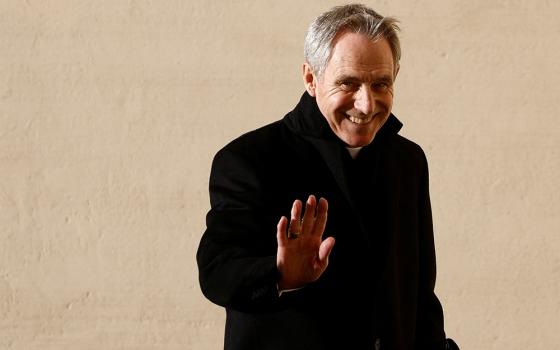Islamic radicalism is causing great consternation these days, and rightly so. Christopher Hitchens has said it represents "an intricate cultural and political challenge that will absorb all of our energies for the rest of our lives," and while other assertions from Hitchens may be open to debate, it's tough to take issue here.
One risk, however, is that the scramble to do something about Islam may obscure other important inter-religious challenges. Dramatic events in India this week illustrate just such a conundrum, one that deserves more attention than it seems to be getting: The worrying rise of Hindu extremism.
Last Saturday, a Hindu nationalist leader named Swami Laxmanananda Saraswati was killed in Orissa, a state on India's east coast that has witnessed several bouts of Hindu-Christian conflict in recent years. (Christians represent roughly two percent of the state's population of 37 million.) Responsibility for the attack, which left five people dead, was claimed by Maoist guerillas, but Saraswati's followers put the blame on Christians. That reaction may have been inevitable, given his history; Saraswati was known for conducting mass "reconversion" ceremonies to bring Christian members of rural tribes back into the Hindu fold. Last December, Saraswati told reporters that irate Christians had attacked him at least seven times over the years in response to his proselytism-in-reverse.
What erupted in Orissa in the days since Saraswati's murder has been characterized by Asia News, a Catholic news agency associated with the Pontifical Institute of Foreign Missions, as an anti-Christian "pogrom."
As of this writing, the unofficial death toll stands at 14, including a 21-year-old lay Catholic missionary burnt alive as she tried to rescue children from a church-run orphanage that had been torched. A priest who worked at the orphanage was also gravely injured. In another incident, a Catholic layman was killed and hacked to pieces. A young nun and social worker was raped, and the building where she worked burned to the ground. Parishes, convents, hospitals and schools have been attacked, along with facilities of other Christian denominations, and families have been forced to take refuge in nearby forests. At least twice, nuns were forced to abandon their vehicles and flee for their lives ahead of angry mobs; one instance involved Mother Teresa's Daughters of Charity, the other the Sisters of the Precious Blood.
According to press accounts, rioters have moved through the area chanting, "Kill Christians and destroy their institutions!" (One presumes it's a bit catchier in Oriya, the local tongue.) Some Christians have pushed back; in one village, according to a report in the national daily The Hindu, Christian and Hindu mobs confronted each another with bombs and firearms. Reports suggest that supplies of food and water are running low. A curfew has been imposed, and on Wednesday authorities issued shoot-on-sight orders for violators in eight Orissa towns.
Today, Aug. 29, the bishops of India have asked Catholic schools to close across the country "as a protest against the atrocities on the Christian community and other innocent people." They have also designated Sunday, Sept. 7, as a day of prayer and fasting "for the promotion of communal harmony and peace in India."
Naturally, accounts of how to assign blame vary wildly. Hindu nationalists claim that foreign Christian missionaries are seducing members of indigenous tribes under the guise of social work, with the connivance of Indian politicians who want their votes. Christian leaders assert that Hindu groups such as the Rashtriya Swayamsevak Sangh (RSS, or "National Volunteer Corps"), the Vishwa Hindu Parishad (VHP, or "World Hindu Council") and the Bajrang Dal (the youth wing of the VHP) are quasi-fascist movements bent on preserving caste privilege and destroying the country's religious minorities.
It's not my intent to sift these claims and counter-claims. Instead, I want to make a simple point: What's happening in Orissa this week ought to be a wake-up call, because the fate of India will be critically important to the 21st century.
This is so for at least three reasons:
First, India is a rising global power. As of 2007, India was experiencing a nine percent annual rate of economic growth, creating a vast new middle class. It's the Microsoft of outsourcing, controlling 85 percent of market share in an industry growing 40 percent every year. India has become self-sufficient in food, a remarkable accomplishment for a country with the world's larges, American mothers told their children to finish their vegetables because there were starving kids in India. Today they're more likely to tell their kids to finish their homework, because otherwise smart kids in India will take their spots in college. All this is giving India new economic and political muscle, and in tandem with a population well in excess of a billion, it's inevitable that India will be one of the three or four most important poles in a new multi-polar world.
Second, India is a great Catholic success story. Catholicism in the 20th century exploded from less than two million faithful to 18 million, ahead of overall population growth, and by 2050 there could be almost 30 million Indian Catholics -- more Catholics, to provide a frame of reference, than England, Australia, Ireland, and Canada combined. It's an inspiring social as well as a spiritual triumph; some 60 to 75 percent of Indian Catholics are either from rural tribes or they're Dalits, meaning the "untouchable" caste, and both groups typically experience the faith as a liberating force from oppression and exclusion. Under the leadership of articulate figures such as Cardinal Oswald Gracias of Mumbai, the Indian Catholic church could be an important interlocutor as India becomes an increasingly influential international player. India is also a leader in the so-called "reverse mission," offering priests to serve in other parts of the world. Since English is the language of the professional class, those priests are especially likely to end up in the United States.
Third, if things break the wrong way, the Indian subcontinent could become the new Middle East -- a perpetually destabilized region whose animosities seed conflict around the world, radicalizing an increasingly large and wealthy global Hindu diaspora. India and Pakistan both now have nuclear weapons, and a long history of mutual suspicion. At the moment, the future direction of Pakistan looks up for grabs. Bangladesh rejected Islam as the basis of the state when the country was created in 1971, but in 1988 the constitution was modified to make Islam the official religion, and radical groups are reportedly on the uptick. Sri Lanka is still wracked by a long-running civil war. The spread of militant Hinduism in this already volatile mix is thus obviously alarming.
What would a compelling Catholic response look like?
To begin with, it's important that relations with Hinduism engage the Catholic mainstream, not just the avant-garde. At least at the level of stereotypes, Hindu-Catholic dialogue has long been dominated on the Catholic side by theologically adventurous souls -- seekers interested in blending Eastern religious practices with Catholic devotions, or exploring parallels between Krishna and Christ. Some watchdogs of Catholic orthodoxy have fingered Indian theologians (especially, whether fairly or unfairly, Indian Jesuits) as among the most dangerous thinkers in the church these days for their ideas on religious pluralism and the salvific role of non-Christian religions.
Without entering into those debates, the reality is that Hindu-Catholic dialogue, if it is to move history, cannot simply mean Catholic progressives and Hindu progressives complimenting one another on their enlightenment. Catholics who stand at the ecclesiastical center, especially at the leadership levels, must reach out to their opposite numbers in the Hindu world -- those who may have influence over Hindus tempted by the rhetoric of the extremists. One model could be the Oasis project of Cardinal Angelo Scola in Venice, and its efforts to engage "popular" Islam.
Post 9-11 and post-Regensburg, there's been significant growth in Catholic/Muslim dialogues, programs in Islamic studies at Catholic universities, and popular Catholic writing on Islam. Before long, a new generation of Catholic scholars, journalists and activists may emerge -- one better versed in Islamic theology and history, with at least a working knowledge of Arabic, and thus positioned to engage Islam at a deeper level. A similar level of energy and commitment ought to be directed toward Hinduism.
It's also important that Catholic leaders avoid adding fuel to the fire, however inadvertently. When Pope John Paul II visited India in November 1999, the headline was his call for a "great harvest of faith" in Asia in the third millennium. While Catholicism obviously cannot renounce its missionary dimension, there's probably no place on earth where a respectful witness to Christ is more easily confused with aggressive proselytism. Bold references to evangelization, especially from a foreign leader, can come across as fighting words. After John Paul's statement, the World Hindu Council called upon Hindus to "unite to face the assault," and the pope's words are still cited as a pretext for anti-Christian activity. This doesn't mean Catholicism in India should "go soft" on the commandment to make disciples of all the nations -- recent growth of the church suggests it clearly hasn't -- but local realities imply discretion about how that commandment is articulated in public, especially by outsiders.
At the grass roots, Catholics around the world can express solidarity -- and not just the spiritual sort -- with the Indian Catholic community. When the violence eventually ebbs in Orissa, the local church will need material help to rebuild, and one prays it will be forthcoming.
Catholics can also influence their governments to insist that India protect religious minorities. (Archbishop Raphael Cheenath of Cuttack-Bubaneshwar claims that police and military forces in Orissa have been slow to intervene for political motives; the state is governed by the nationalist Bharatiya Janata Party, or BJP.) American Catholics may be well positioned to make such an appeal, because India has been a rare foreign policy success for the Bush administration. The White House sees India as a partner in the war on terror and has countenanced India's entry into the nuclear club. This would be a good time for the American government to cash in some of its political capital to insist that religious minorities receive the protection promised by the Indian constitution.
As the old maxim goes, success is a matter both of doing things right and of finding the right things to do. In the 21st century, taking India and Hinduism seriously is certainly a right thing to do; the challenge, for Catholics as for everybody else, is to do it right.
* * *
On Tuesday, the Vatican Press Office released the following statement about the events in India:
"In reference to the tragic news coming from India concerning violence against the faithful and the institutions of the Catholic church, the Holy See, while expressing solidarity with the local churches and religious congregations involved, condemns these acts that injure the dignity and liberty of persons and compromise peaceful civil co-existence. At the same time, it appeals to all parties so that, with a sense of responsibility, all oppression may be ended and a climate of dialogue and mutual respect may be restored."
* * *
Here's a brief update on last week's column, which floated the idea of Orthodoxy playing a peace-making role in the conflict between Russia and Georgia over South Ossetia. This week Russia recognized the independence of South Ossetia and the other breakaway Georgian province of Abkhazia, a move criticized by the United States and other nations.
Notably, the Russian Orthodox Church did not immediately assert ecclesiastical jurisdiction over the two provinces. A spokesperson for Patriarch Alexy II of Moscow said the status of the territories "must be determined in the canonical field during the course of dialogue between two churches," meaning the Georgian Orthodox Church and the Russian Orthodox. He also noted that Alexy had sent a congratulatory note to Georgian Patriarch Ilia II on the 45th anniversary of his elevation to the hierarchy, which was August 25.
Archbishop Feofan, the Russian Orthodox leader in North Ossetia, echoed the restrained tone.
"The actions of the churches must be a bridge for preserving the historic tradition of good relations between the peoples of Russia and Georgia," he told a Russian news agency. "The church by its nature is called to a peacemaking mission."
Though it's early in the game, these gestures suggest a desire on the part of the Russian Orthodox not to exploit the present conflict and to keep lines of communication with Georgia open. One prays it continues.
The e-mail address for John L. Allen Jr. is jallen@ncronline.org




